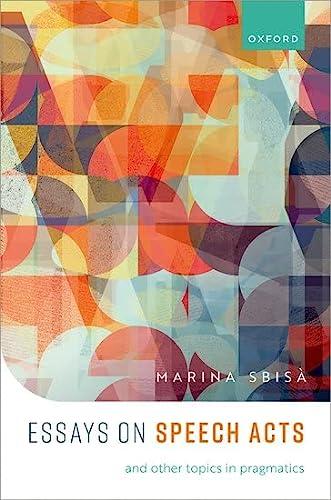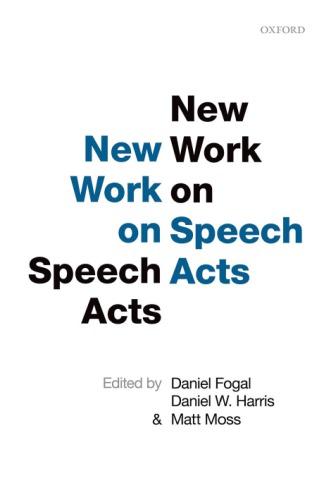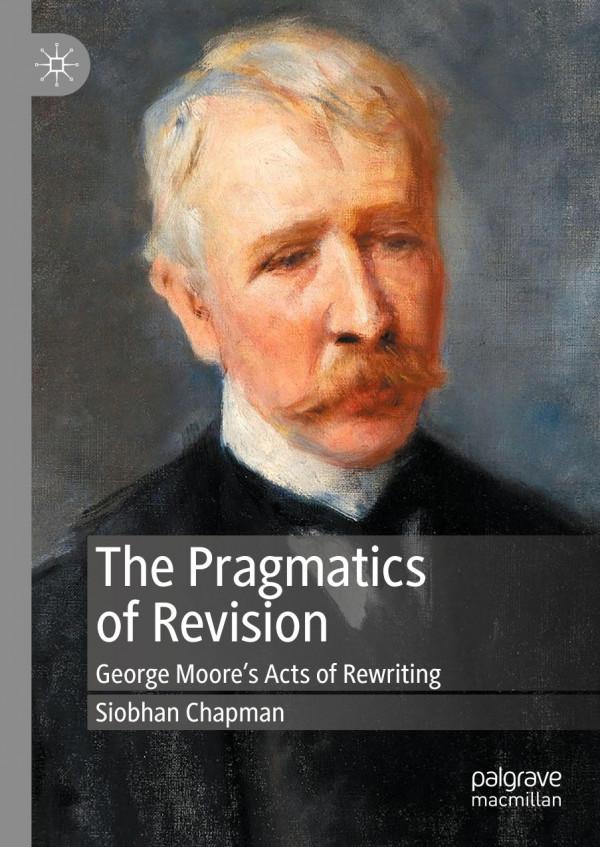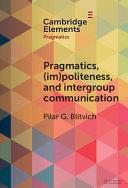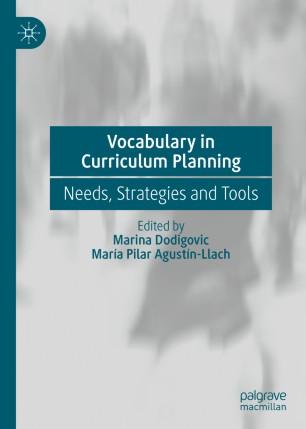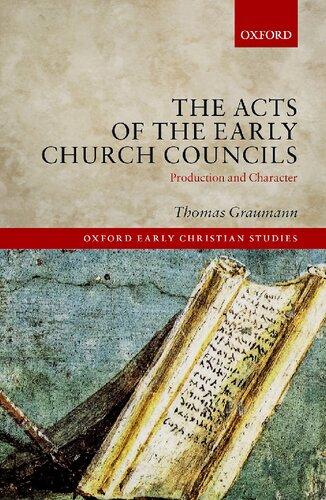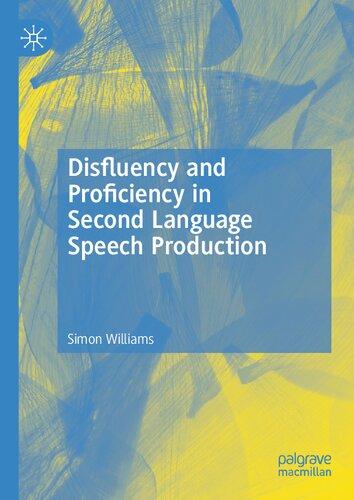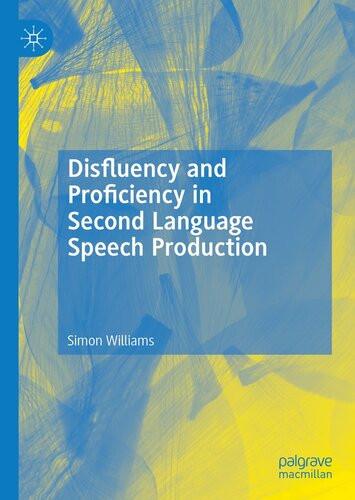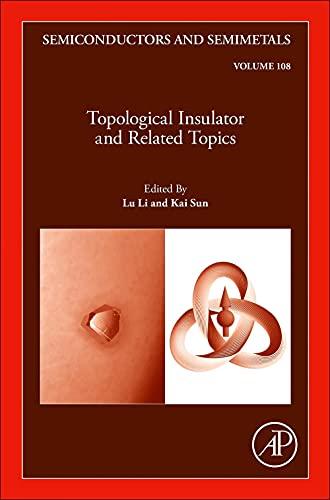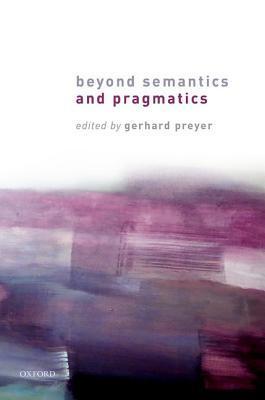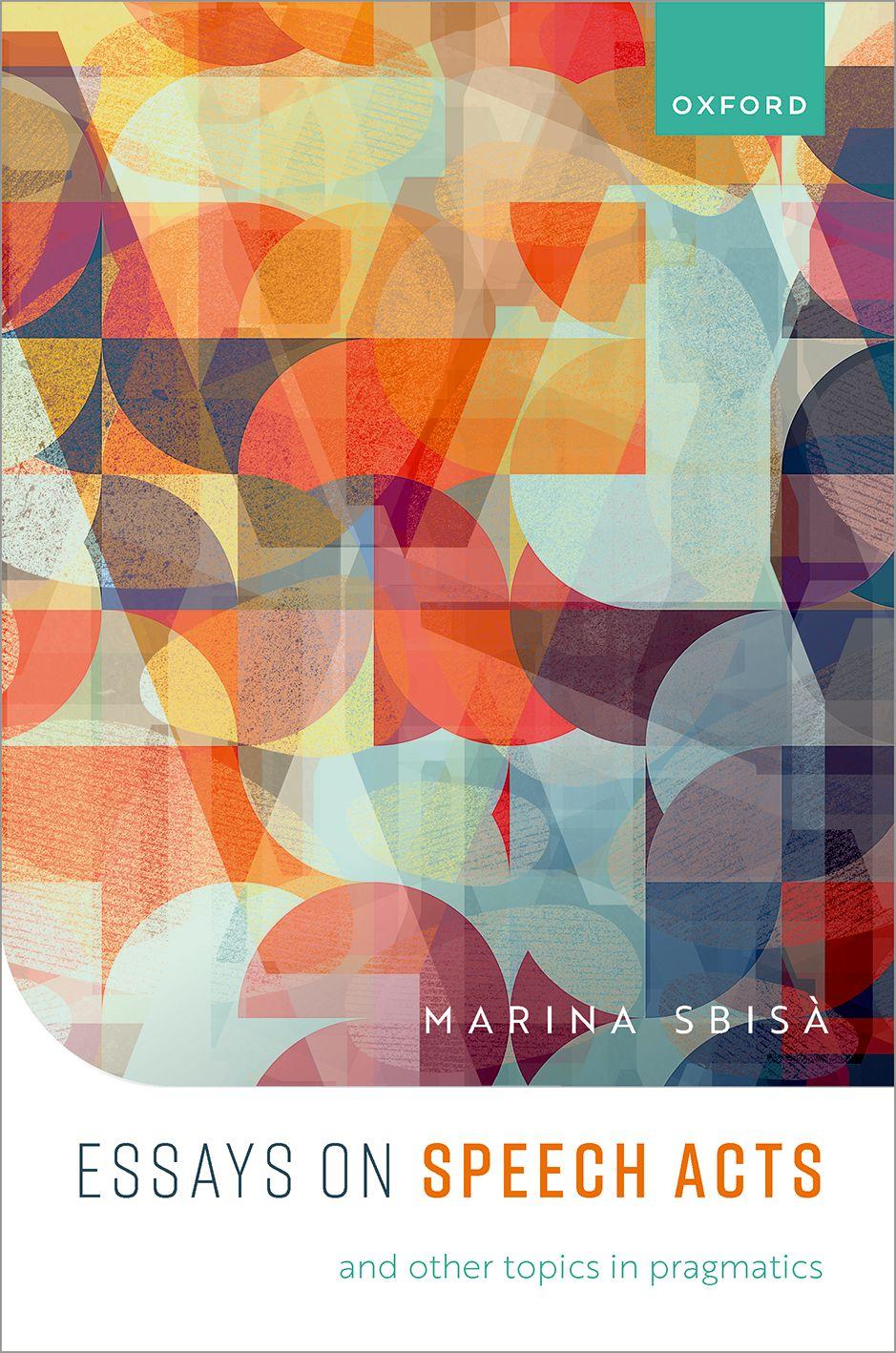EssaysonSpeechActs andOtherTopicsin Pragmatics
MARINASBISÀ
GreatClarendonStreet,Oxford,OX26DP, UnitedKingdom
OxfordUniversityPressisadepartmentoftheUniversityofOxford. ItfurtherstheUniversity’sobjectiveofexcellenceinresearch,scholarship, andeducationbypublishingworldwide.Oxfordisaregisteredtrademarkof OxfordUniversityPressintheUKandincertainothercountries ©MarinaSbisà2023
Themoralrightsoftheauthorhavebeenasserted Allrightsreserved.Nopartofthispublicationmaybereproduced,storedin aretrievalsystem,ortransmitted,inanyformorbyanymeans,withoutthe priorpermissioninwritingofOxfordUniversityPress,orasexpresslypermitted bylaw,bylicenceorundertermsagreedwiththeappropriatereprographics rightsorganization.Enquiriesconcerningreproductionoutsidethescopeofthe aboveshouldbesenttotheRightsDepartment,OxfordUniversityPress,atthe addressabove
Youmustnotcirculatethisworkinanyotherform andyoumustimposethissameconditiononanyacquirer
PublishedintheUnitedStatesofAmericabyOxfordUniversityPress 198MadisonAvenue,NewYork,NY10016,UnitedStatesofAmerica
BritishLibraryCataloguinginPublicationData Dataavailable
LibraryofCongressControlNumber:2022951821
ISBN978–0–19–284412–5
DOI:10.1093/oso/9780192844125.001.0001
PrintedandboundintheUKby ClaysLtd,ElcografS.p.A.
LinkstothirdpartywebsitesareprovidedbyOxfordingoodfaithand forinformationonly.Oxforddisclaimsanyresponsibilityforthematerials containedinanythirdpartywebsitereferencedinthiswork.
1.OnIllocutionaryTypes23
2.SpeechActs,Effects,andResponses43
3.IdeologyandthePersuasiveUseofPresupposition53
4.IntentionsfromtheOtherSide72
5.Presupposition,Implicature,andContextinTextUnderstanding90
6.IllocutionaryForceandDegreesofStrengthinLanguageUse105
7.SpeechActsinContext129
8.CognitionandNarrativityinSpeechActSequences144
9.TwoConceptionsofRationalityinGrice’sTheoryofImplicature167
10.HowtoReadAustin181
11.UptakeandConventionalityinIllocution195
12.IllocutionandSilencing212
13.TheAustinianConceptionofIllocutionandItsImplications forValueJudgmentsandSocialOntology219
14.VarietiesofSpeechActNorms231
15.WaystoBeConcernedwithGenderinPhilosophy254
16.AssertionamongtheSpeechActs267
17.IllocutionandPowerImbalance288
Preface
Thisvolumecollectsseventeenpapersofminedealingwithspeechactsand relatedissuesofapragmaticcharacter,coveringarangeofthirty-sixyearsfrom 1984to2020.TheideaandthedecisiontosubmitthecollectiontoOxford UniversityPresswereinspiredbyRaeLangton,towhomIamextremelygrateful. IamalsogratefulforadviceandsupportonthisprojecttoClaudiaBianchi,Laura Caponetto,BiancaCepollaro,andPaoloLabinaz.Itwasnoeasymattertoreview mylifethroughitsacademicproductsbut,intheend,themainlines,motivations, andoutcomesofmyapproachtospeechasactionhavenowemergedwithmuch greaterclaritythanbeforefromthenumerousseparatepapersscatteredacrossthe yearsandaroundvarioussitesofpublication.Thepapersareorderedbydateof composition.
Ihavedeliberatelyexcludedfromtheselectionpapersofamerelyintroductory nature,reviewarticles,papersaddressedtoanItalianreadershipanalysingsamplesfromtextsorconversationsinItalian,andworkswrittenincollaborationwith otherauthors.Sixteenofthepapersselected,alreadypublishedinEnglish,were subjecttosomeediting(especiallyconcerninglanguage,style,andfootnotes), whileonepaperwastranslatedintoEnglishfromItalian.Anynewfootnotesor additionstotheoriginalonesareinsquarebrackets.Allreferenceshavebeen gatheredinonelistattheendofthevolume.
IamgratefultoanenormousnumberofpeoplewhomImetinthecourseofmy careerforexchangesofviews,discussion,collaboration,encouragement,orhelp withtheEnglishofmypapers.Theyinclude:BrunoAmbroise,AnitaAvramides, ElvioBaccarini,ThomasBallmer,LynnBaker,CarlaBazzanella,ClaudiaBianchi, PaoloBouquet,ClaudiaCaffi,LauraCaponetto,BiancaCepollaro,ElenaCollavin, FrançoisCooren,AliceCrary,PaoloFabbri,GioloFele,AnitaFetzer,Michel Fournel,BruceFraser,ChristopherGauker,Hans-JohannGlock,MitchGreen, SanfordGoldberg,WilliamHanks,MikeHarnish,DavidHoldcroft,Jennifer Hornsby,AndreasKemmerling,PaoloLabinaz,EricLandowski,RaeLangton, PaoloLeonardi,BarryLoewer,DiegoMarconi,JacobMey,JudyMoss,Gabriella NuciforoPaoletti,EtsukoOishi,HermanParret,CarloPenco,SnježanaPrijćSamaržjia,PaolaRodari,FrançoisRecanati,ConstantineSandis,JenniferSaul, KenTurner,AchilleVarzi,JefVerschueren,TimWilliamson,IwonaWitczakPlisiecka,MaciejWitek,TomoyukiYamada,andIgor Žagar(thelistshouldalso includemembersofmyfamily,buttheyprefernottoappear).
Amongthepeoplewhocontributedtomyformationinearlyyears,Iwouldlike torememberAmedeoG.Conte,Maria-ElisabethConte,CarmelaDiLalloMetelli,
GaetanoKanizsa,AnthonyKenny,EugenioLecaldano,BrianMcGuinness,Guido Morpurgo-Tagliabue,RenzoPiovesan,andJamesO.Urmson.Iamalsoextremely gratefultoGeorgeWilsonandPaulSmolenskyandtheDepartmentsof Philosophy,andrespectivelyCognitiveScienceofJohnsHopkinsUniversityfor jointlyhostingmeasaVisitingScholarinSpring1999,toBrianMcLaughlinand theDepartmentofPhilosophyofRutgersUniversityforhostingmeasaVisiting ScholarinFall2002,toMagdalenCollege,Oxford,forhostingmeasaVisiting FellowinHilaryTerm2006,toSandraLaugierandBrunoAmbroiseforinviting measaVisitingProfessorattheUniversityofAmiensandatCURAPP(CNRS) (France)inMay2010,tothePhilosophyFacultyofOxfordUniversityforhosting measanAcademicVisitoronvariousoccasionsbetween2008and2017,andto NewCollege,Oxford,forhostingmeasaVisitingFellowonthesponsorshipof TimothyWilliamsoninTrinityTerm2019.
Introduction
Theessayscollectedinthisvolumeexaminethecategoriesofspeechacttheory andapplyanddeveloptheminthecontextofnaturaldiscourseandconversation, withthepurposeofprovidinganaccurateanalysisofhowspeechcanbeaction. Particularattentionispaidtonormativeaspectsoflanguageandlanguageuse, withaneyetounderstandingthesocialandpoliticaldimensionsoflinguistic activity.Issuesconcerningimplicitnessarealsoconsideredinthesamelight.
InSection1ofthisIntroduction,Ishallbrieflyintroducemyapproachto speechactsandtoimplicitness.InSection2,Iintroducethecontentsoftheessays collectedhereandthecontributionstheymaketospeechacttheoryorneighboringpragmaticissues.Sincethecollectionrangesoverdifferentstagesinthe developmentofmyviews,Section3willbedevotedtoprovidingsomenarrative background:howmythoughtswereformed,whatvoicesinfluencedthem,and howeachessay fitsinthegeneralcontextofmyresearchactivities.Section4 providessomedetailsaboutmycurrentviewsastheyhaveevolvedasaresultof theresearchactivitythatthiscollectionofessaysatteststo.
1.TheApproach
MyapproachtospeechactsisinspiredbythephilosophyoflanguageofJohn L.Austin.Thecentralcoreofmyworkisthereflectiononthenatureofillocution, accompaniedbytheinvestigationofhowillocutionworksinnaturallyproduced speech.Austin’sconceptionofillocutiongoesbeyondthereceivedideathat languageservesvariousfunctionsbyidentifyingonekindofthingthatisdone inspeaking,illocution,anddistinguishingitfromspeechitselfontheonehand, andthegoalstowhichlinguisticactivityisdirectedontheother.Itisalso innovativebecauseitdoesnotperpetuatetheusualoppositionbetweenspeech actsperformedinutteringdeclarativesentencesandotherspeechacts,but insteadaimstothrowlightonthefactthatutterancesofanykindmayembody anillocution.
IfollowAustinintakingillocutionaryactstobe “conventional. ” Bythis,Imean aboveallthattheeffectstheybringaboutareconventional:theyarenottheoutput ofachainofcauses,which,oncetheyarethecase,cannotbe “undone ” (ormade nevertohavebeenthecase),butratherstatesofaffairsthatobtaindependingon socialorinterpersonalagreementaboutthespeaker’sperformanceandthenorms
.MarinaSbisà,OxfordUniversityPress.©MarinaSbisà2023. DOI:10.1093/oso/9780192844125.003.0001
governingit,andareannulledifthespeaker’sperformanceisfoundtobedefective incertainways.Thisideaoftheconventionalityofillocution fitswithAustin’ s claimthatspeakers,inordertomaketheirillocutionaryacts “takeeffect,” must “ secure ” theaudience’suptake(1975,116–17).
Idescribeillocutionaryeffectsintermsofattributionsorcancellationsof deonticpropertiestoandfromtheparticipantsinaninteractionalevent.By “deontic ” propertiesImeansuchpropertiesashavingaright,beingentitledor havingtheauthoritytodosomething,havingtodosomething(becauseobliged orlegitimatelyexpectedtodoso,orcommittedtodoingso),andbeingrecognized ascapableofdoingsomethingorknowledgeableaboutsomething.Thesepropertiesbelongtoagentsinvirtueofsocialorinterpersonalagreement.
Thiskindofdescriptionofillocutionaryeffectsrepresentsparticipantsina linguisticexchangeashavingatanygiventimeacertainsetofdeonticproperties onthebasisofwhichtheyperformspeechactsandwhichisalteredbythespeech actstheyperform.Thisissimilar,ontheonehand,tothe “modalcompetence ” of narrativesemiotics(GreimasandCourtés1979,54)whicheachactantmustbe assignedateachstepofanarrativeandwhichchangesasthenarrativeproceeds and,ontheother,toDavidLewis’ s “scorekeeping” associatedwitheachparticipantinalanguagegame,whichvariesdependingonthemovestheymake(Lewis 1979).Myideadiffersfromboth “modalcompetence ” and “scorekeeping” because,whiletheytakeintoconsiderationamixtureofdeonticmodalitiesand variousotherattitudes,Ifocusonthesub-setofdeonticpropertieswhichare assignedtoagentsorwithdrawnfromtheminaconventionalanddefeasibleway (changesinattitudessuchasdesireorbelief,instead,aremattersoffactpertaining toindividualorsocialpsychology).
Theparticipantsinaneventofverbalinteractionareusuallyassumedtobe speakerandhearer(oraudience),butaccordingtomyanalysis,furtherdistinctionsmustbeintroducedinordertoaccountforthedifferentrolesthatspeakers andaudience,ormembersoftheaudience,playinthedynamicsofillocution. Speakersareresponsiblefortheillocutionaryeffectsoftheirutterances,butthe illocutionaryeffectitselfdoesnotmerelyaffectonetargetparticipant:itaffectsa relationship,sincetoanychangeinthedeonticpropertiesofoneoftheparticipants,therecorrespondsanotherchangeinthedeonticpropertiesofanother (includingtheparticipantwhoisalsoresponsiblefortheillocutionaryact). Representingparticipantsinaninteractionaleventasendowedwithdeontic properties,andtheirsetsofdeonticpropertiesaschangingovertimeasaneffect ofthelinguisticexchange,enablesustorealizehowillocutioncontributesto formingandmodifyinginterpersonalandsocialrelations,includingpower relations.
Iagreewiththetradition(notonlyAustinbutalsoGriceandStrawson)thatthe performanceofanillocutionaryactmustberecognizableassuch.ButsinceIalso takeitthatillocutionaryeffectsarebroughtaboutthankstosocialorinterpersonal
agreement,Iassignanimportantroletohowanutteranceisreceivedand respondedto.Inwaysandtoanextentdependingonthenatureandstructure oftheinteractionaleventinwhichanutteranceisframed,theuptakeofthe relevantparticipantsestablishes,orcontributestoestablishing,whatillocutionary actwasperformed.
Aboutinfelicities,Imaintainthatattemptsatperformingillocutionaryactsmay failifthecircumstancesareinappropriateortheexecutionisgravely flawed,while utterancesachievetheirillocutionaryeffectiftheinfelicityconsistsmerelyinthe absenceoftheappropriatepsychologicalstatesofthespeaker.However,Idonot takefelicitytobeamatterofcomplyingwithnecessaryandsuf ficientconditions: whenitisclearenoughwhatanillocutionaryactanutteranceisdesignedto perform,itisassumedbydefault,thatis,unlessthereisreasontosuspectthat somecircumstanceisinappropriateorthereissome flawintheexecutionorthat thespeakerlackstheappropriatepsychologicalstates.
Illocutionaryacts,soconceived,shouldbeclassi fiedaccordingtotheeffects theyproduceormoreprecisely,accordingtothewholeconfigurationofdeontic propertiesinwhichtheirpreconditionsandtheireffectsconsist.Fouroutof fiveof Austin’sclassesofillocutionaryactsaresuitableforbeingcharacterizedinthis way.So,inmytheoreticalconsiderationsaboutillocutionaswellasinmyuseof illocutionintheanalysisofdiscourseorconversation,Ihighlightfourmain illocutionarytypes,correspondingtomyre-definitionsoftheAustinianclasses ofVerdictives,Exercitives,Commissives,andBehabitives.InAustin’sclassof Expositives,variousconfigurationsofdeonticpropertiescanbefound,whilethe contentsofthosedeonticpropertiesconcernmattersrelatedtothestructureand developmentofdiscourseorconversation.So,itispossibletoidentifyagroupof ExpositiveswithineachofthefourmainclassesofVerdictives,Exercitives, Commissives,andBehabitives.
Speechactsareusuallyconsideredasaspecial,self-containedtopicinpragmaticsandnotasathemewhosein-depthtreatmentcanshedlightonother issues.Infact,howspeechactsareconceivedisofteninfluencedbythewaysin whichissuessuchaspresuppositionandcommongroundor,respectively,implicatureandrelevance-driveninferences,aredealtwith.Butmywaywithspeech actshasimplicationsforhowtodealwithissuesconcerningimplicitness.If implicitnessisviewedasaphenomenonconcerningthespeechact(atsome levelorother),itbecomesnaturaltoinquireaboutthefunctionsitserveswith respecttowhatthespeakerisdoingwiththeirwords.Inparticular,suggestions aboutwhenandwhyspeechactsconveycertainkindsofimplicitcontentmay comefromtheinvestigationofthedynamicsofillocution.Ifnotonlyillocutionary felicitybutalsotheappropriatenessofutterancesandtheparticipants’ cooperativityareassumedbydefault(thatis,unlesstherearereasonsnottodoso),this maybeusedtoaccountforbothso-calledpresuppositionaccommodationandthe workingoutofconversationalimplicature.
Mymainideaaboutpresuppositionisthatitismisleadingtogivetwodistinct accountsofspeakerpresuppositionandpresuppositionaccommodation.Asactivatedbyaspeechact(oralso,byatextcomprisingvariousspeechacts),presuppositionshouldberecognizedasoneandthesamephenomenonwhetherthe presupposedcontentisalreadysharedornot.Thisismadepossiblebyconsideringpresuppositionsnotassharedassumptions,butasassumptionswhichought tobeshared.Thespeechactrequirestheassumptionthatthingsareinacertain waytobetrueforitsownappropriatenessorfelicity,irrespectiveofwhetherwe accommodatethatassumptionoralreadyknowthatthingsareso.Thisviewof presuppositionaccountsforitsinformativeandpersuasivefunctionsaswellasfor thecasesinwhichthecontentthatislinguisticallymarkedaspresupposedisalready partofthecommonground.Presuppositionsencodecontentthatmaybenewforat leastsomemembersoftheaudienceinasyntacticallycompactandtherefore economicwayandhelpthespeakeravoidthe(face-threatening)implicationthat nooneintheaudiencealreadypossessesthatinformation.Presuppositionsmake theaddresseeofaspeechactfeeltheyareamemberofthegroupassoonasthey share,oraccepttoaccommodate,thepresupposedassumptions.Thefactthat challengingpresuppositionsiscostly,bothcognitivelyandinteractionally,explains whytheyaresuitableforconveyingcontentthatthespeakerdoesnotwanttobe challengedandmaybeexploitedasapowerfulmeansofpersuasion.
Astoimplicature,Iconsideritfromthepointofviewoftheaudience. Ithereforefocusonwhyitislegitimatetounderstandthespeaker’sutteranceas havingacertainimplicatureandhowtheimplicatedcontentcanberetrieved. Implicaturemakesadditionalorredressiveinformationavailabletotheaudience. Itbackgroundsthespeaker ’scommitmenttothecontentmadeavailableand involvestheaudienceintheprocessofworkingitout,thusfosteringasortof complicitybetweenspeakerandaudience.
Idistinguishpresuppositionfromimplicaturebytwomaincriteriainspiredby thewaysinwhichtheircontentsaremadeexplicitandbythefunctionstheyhave withrespecttotheoverallsignificanceofatext.Intheexplicitationofan implicature,weinferacontentthatisnotexpressedonthetext’ssurface;inthe explicitationofapresupposition,wereformulateandforegroundcontentwhichis alreadypresentinthetextinabackgroundedform.Likewise,acontentcannotbe (merely)madeavailablebyimplicaturewhenitisexplicitlyaffirmed,while contentlinguisticallymarkedaspresupposedcanbeatthesametimespelled outexplicitlywhilestillconservingthestatusofpresupposedinformation.
2.TheEssays
InEssay1, “OnIllocutionaryTypes” (publishedin JournalofPragmatics,1984), Iexaminetheclassi ficationofillocutionaryactsoutlinedbyJohnL.Austinand
elaborateuponit.IreconsiderAustin’sfourclassesofExercitives,Commissives, Verdictives,andBehabitivesandcharacterizethemasinvolvingdistincttypesof conventionaleffectontheinteractionalrelation.Thesetypesofeffectare describedintermsofassignmentorcancellationofdeonticpredicatestoor fromtheparticipantsandtothepurposeofthisdescription,theparticipantsare consideredintermsofthe “actants ” theyexpress,borrowingthisnotionfrom narrativesemiotics.Illocutionisthuspresentednotasamatterofaspeaker achievinganeffectontheaudience,butofaDestinatorassigningorwithdrawing deonticpropertiestoorfromeachoneoftwoDestinees,thusaffectingtheir relation.
Shortly(andapproximately)said,inExercitives,Commissives,andVerdictives, theDestinatorhasadeonticpropertyofthe “ can ” kind(amountingtosomekind ofauthority,recognizedcapacity,orrecognizedcompetence),whileinBehabitives theDestinatorfulfillsthetaskofreactingtosomeaction,event,orsituationand hasthereforeadeonticpropertyofthe “ought” kind.Therelationshipbetween Destinee1andDestinee2ischangedbyExercitivesbycreatingoreliminating obligationsandbyCommissivesbyassigningarightorlegitimateexpectationto Destinee1andanobligationtoDestinee2.BothVerdictivesandBehabitives entitleDestinee1topossessknowledge,butinthecaseofVerdictives,itisthe knowledgeformulatedinthespeechactandDestinee2isassignedtheobligation toguaranteeforit,whileinthecaseofBehabitives,itistheDestinator’sreaction itselfwhichbecomesanobjectofknowledgeforDestinee1,whileDestinee2is freedfrompreviousobligationsasregardsDestinee1,sothattheirrelationcan haveanewstart.
Austin’sillocutionaryclassesoverlapwithoneanotherandhavefuzzyborders. Iclaimthatthisisnotaweakness,butastrongpointofhisclassification(or typology),sinceitenablesustotacklevariouscomplexitiesintheanalysisofboth illocutionaryverbsandtheillocutionaryforceofutterancetokens.Likewise, distinguishingillocutionarytypesinthewayIproposeisnotpidgeon-holing existingpractices,butoutlininga flexibledescriptivemechanism,capableto accountformarginalandhybridcasesaswellasprototypicalones.Iconclude Essay1withaninvitationtousethetypologyitpresentsasapointofdeparturefor furtheranalyses,castintheformoftheproposalofsomespeech-acttheoretical “ games ” onemightwanttoplaywithit:groupingtypesaccordingtosimilarities, shiftingakindofillocutionaryactortheillocutionaryforceofatokenutterance fromatypetoanother,reframingtheillocutionaryactperformedinissuinga tokenutterancewithinagroupofillocutionarytypestowhichitwouldnotbe expectedtobelong.
Essay2, “SpeechActs,Effects,andResponses,” writtenasareactiontoJohn Searle ’ spaper “Conversation” andpublishedinacollectiondiscussingit(Searle etal.1992,7–29),examinestherelationshipbetweenindividualspeechactsand conversationalsequences.Init,Iclaimthatinsteadofinquiringwhetheronecan
extendspeechacttheory(withthereceivedapparatusoffelicityconditions)tothe studyofconversation,oneshouldconsiderthatthestudyofspeechactsalready presupposessomereferencetoconversationalsequences.ReadingAustinas claimingthatthehearer ’suptakeisnecessaryforanillocutionaryacttotake effect,Isuggestthattheresponsetoaspeechact,whichmanifestshowthe interlocutorunderstoodit,contributestolettingthatspeechacttakeeffect accordingtoacertainillocutionaryforce.Whileadmittingthattherearecases inwhicharesponsethatisinappropriatetotheapparentforceofaspeechactcan bedismissedasduetomisunderstanding,Iarguethatinthecourseofinformal conversations,theresponsethataspeechactactuallyreceivesoftenrevealshowit wastakenandwhatillocutionaryeffectitbroughtabout.So,inordertotellwhat anillocutionaryactisperformedinissuinganutterance,weshouldnotconsider thatutteranceinisolation,butframeitwithintheconversationalsequenceto whichitbelongs.
InEssay3, “IdeologyandthePersuasiveUseofPresupposition,” firstpresented atthe6thInternationalPragmaticsConference(1998),whosespecialtopicwas “LanguageandIdeology,” Ishowhowpresuppositionisusedtoconveynew informationandeventoachievepersuasion(especiallyin fieldspertainingto ideology),bydiscussingexamplesdrawnfrompoliticalnewsinItaliandaily newspapers.Ichallengethereceivedaccountofpragmaticpresuppositionas unabletoyieldaplausibleexplanationofthesephenomena,andarguethat presuppositionandpresuppositionaccommodationshouldnotbegiventwo separateaccounts:instead,presuppositionshouldberecognizedasoneandthe samephenomenon,irrespectiveofwhetherthepresupposedcontentisalready sharedornew.Iproposetoconsiderpresuppositionsnotassharedassumptions, butasassumptionswhichoughttobeshared.Thisnormativefeaturehelps accountfortheirinformativeandpersuasiveuses.Againsttherisksofuncritical persuasion,Ialsoclaim,the firstdefenseliesintheabilitytomakepresuppositions explicit,turningthemintoassertionsorassessmentsthat,beingopenlyperformed,donotescapeconsciouscontrolandareliabletocriticism.
Essay4, “IntentionsfromtheOtherSide,” readattheConference “PaulGrice’ s Heritage” (S.Marino,InternationalCenterforSemioticandCognitiveStudies, 1998),revisitsPaulGrice’sphilosophyoflanguage.ItexaminesthreeGricean ideas:non-naturalmeaning,theCooperativePrinciple,andthenotionofaperson thatGriceputsforwardinthecontextofhistheoryofvalue.Myapproachtothose ideasdoesnotfocusonthespeaker’smindanditsinternalstates,butonthe audienceandhowtheyshouldtakethespeaker’sutterances.Viewingnon-natural meaning “fromtheotherside ” (asthetitleofEssay4reads)amountstoreformulatingitsGriceandefinitionasspellingoutwhatintentionstheaudienceshould attributetoaspeakerwhenconsideringthatspeakerasnon-naturallymeaning something.Likewise,theCooperativePrincipleanditsmaximsarenorulesthat mustbeactuallyfollowedbyspeakers,butassumptionsinthelightofwhichthe
audiencecanbestunderstandspeakersandwhichspeakersmayexploittomake themselvesunderstood.So,sometraditionalobjectionstoGrice’sdefinitionof non-naturalmeaningturnouttobeharmlessandtheuseoftheCooperative Principleintheanalysisofdiscourseisfullyjustified.AstoGrice ’snotionofa personastheessentiallyrationalbeing(1991),suchanessenceofpersonhoodis anobjectofself-attributionbyhumanbeingsanditsbordersarefuzzy:asone wouldexpectfromanessencethatis(sotospeak)essentiallyattributed,therewill alwaysbeborderlinecases,inwhichitisunclearwhethertheattributionisdueor not.Itakethisasconfirmingmyintuitionthatthereisanethicalburdenimplicit intherecognitionofothersassubjects.
InEssay5, “Presupposition,Implicature,andContextinTextUnderstanding,” readataConferenceoftheinternationalinterdisciplinarynetwork “Context” held inTrentoin1999,Isketchanoverviewofthe fieldofimplicitnesswhichhasits rootsinmyAustin-inspiredspeech-acttheoreticalperspective.Iexaminetheroles thatpresuppositionandimplicatureplayintheprocessoftextunderstanding. Contextispartofthepictureintwoways:astheobjectiveandmind-transcendent contexttowhichlinguisticallyindicatedpresuppositionshavetoconform(andare bydefaulttakenasconformingto)andastherepresentationofcontextwhose constructionandupdatearepartoftheprocessoftextunderstanding.Idescribe presuppositionandimplicatureastwodifferentwaysinwhichchangesinthe representationofthecontextareinduced,bothdifferentfromthewayinwhich assertionchangesit.Onthebasisofthisdescription,Iclaimthattherearegood reasonstoconsiderpresuppositionandimplicatureasdistinctlinguisticpragmaticphenomena.Indeed,alinguisticallyactivatedpresuppositionremains suchevenifitscontenthasalreadybeenasserted,whilethepreviousassertionof thesamecontextmakesanimplicatureuselessandthereforepreventsitfrom arising.
Essay6, “IllocutionaryForceandDegreesofStrengthinLanguageUse” was alsowrittenin1999,withtheintentofdrawingmyownconclusions after conductingfurtherresearchonmyownintospeechactsinconversation from mypreviouscollaborationwithClaudiaCaffi andCarlaBazzanellaonmitigation andreinforcement(seeBazzanella,Caffi,andSbisà1991).Ifeltuneasyaboutsome oftheresultsofthatjointresearch,especiallyastoitstaking “propositions ” asone oftheaspectsofthespeechactwhosemodificationscontributetovariationsin whatwecalledthe “degreeofstrength ” ofillocutionaryforce(followingSearle’ s terminology:Searle1979,5;SearleandVanderveken1985).Themainideain Essay6isthatthosevariationsaffectaspectsoftheillocutionaryeffectandofits preconditions,bothofwhichconsistindeonticpropertiesoftheparticipants. Analystsdonotfacetwophenomena,illocutionaryforce(orillocutionarypoint) ontheonehand,andmitigation/reinforcementontheother,buthaveonlythe (multi-faceted)taskofdescribingthedynamicsofillocutioninitsshades (bothqualitativeandquantitative)anditsrelationstothelocutionaryand
perlocutionaryaspectsofthespeechact.Insupportoftheclaimthatmitigation andreinforcementareadjustmentsoftheillocutionaryeffectsofutterances, IanalyzeexamplesfromrecordedconversationsinItalian.Thepaperwassubmittedtothe JournalofPragmatics andwasacceptedafterlengthyandinstructive discussions.
Essay7, “SpeechActsinContext,” writtenin2000,examinesthenotionof contextanditsusesinspeechacttheory.Iclaimthattherequirementsforthe felicityofperformativeutterancesdiscussedbyAustinhavetobesatisfiedbyhow thingsareobjectively,whileSearle’sfelicityconditionsaremostlyrequirementson thespeaker’sintentionsandotherattitudes.Ithenargueinfavorofaviewofthe contextofaspeechactasconstructed(therefore,potentiallydynamic)asopposed tomerelygiven,limitedasopposedtoindefinitelyextendable,and(insofarasthe speechacthastobeassessedagainstit)objectiveasopposedtocognitive.Ialso reaffirmthecontext-changingroleofspeechactsandthedifferencebetweenthe illocutionaryandperlocutionarydimensionsofthechangestheybringabout.
InEssay8, “CognitionandNarrativityinSpeechActSequences,” readatthe 7thInternationalPragmaticsConference(2000),Iexaminetheinteractional dynamicsofspeechacts,makinganextensiveuseofexamplesfromnatural conversationsandpayingparticularattentiontospeechactsequences.Idevelop someoftheinsightsaboutthehearer’suptakethatwerealreadypresentinEssays 1and2,arguingthatwhatisconstitutiveoftheaudience’suptake(andtherefore contributestomakingthespeaker’sutteranceillocutionarilyeffective)arethe audience’sverbalandbehavioralresponsesasopposedtotheircognitiverepresentationofwhatthespeakermeant.Ithenshowhowtheanalysisofaction sequencesputforwardbynarrativesemiotics,whichenvisagesathree-place structure(thenarrativeschema)consistingofamanipulatingmove,anaction, andasanctioningmove,canbeusedtoobtainabetterunderstandingofwhatis goingoninaspeechactsequence,sheddinglightonthesequentialrelations betweenspeechacts.Ialsodemonstratethatthenarrativeschemacanbeapplied tothesameconversationalsequencesindifferentpositions,revealingavarietyof possiblesequence-dependingaspectsforeachconversationalcontribution.
InEssay9, “TwoConceptionsofRationalityinGrice’sTheoryofImplicature,” readattheinternationalconference “RationalityinBeliefandAction” heldin Rijekain2004,ItakeanotherlookatGrice ’sphilosophyoflanguage.Iexplore whyconversationalimplicatureisconsideredbyGrice,aswellasbypost-Gricean andneo-Griceanscholars,assomething “rational” andshowthattwodistinct conceptionsofrationality, “instrumental” and “argumentative,” co-existinGrice’ s thought.The “instrumental” rationalityofconversationalimplicatureisbased ontheefficacyoftheCooperativePrincipleinmaximizingunderstanding:conversationalimplicatureisrationalinthissensebecauseconversationismoreefficientif theCooperativePrincipleisassumedtohold. “Argumentative” rationality,onthe otherhand,isamatterofhavingreasonsforwhatonesaysordoes:ifwefocuson
it,conversationalimplicatureisrationalbecauseitiscalculable,thatis,retrievable byreasoninginaccordancewithacertainargumentativepath.Whilepost-and neo-Griceantheories(SperberandWilson1995;Levinson2000)focusoninstrumentalrationality,Grice’sposthumouswritingsonvalueandreason(1991,2001) payattentiontoargumentativerationality.Iarguethatconversationalimplicature isbestunderstoodinthelightoftheargumentativeconceptionofrationality.
Essay10, “HowtoReadAustin, ” originallyreadasaplenarylectureatthe 9thInternationalPragmaticsConference(2005),specialtopic “Pragmaticsand Philosophy,” reassessesthecontributionstopragmaticsmadebyJohnL.Austin’ s HowtoDoThingswithWords.Idiscusssomeoftheassumptionsmadebythe receivedreadingsofthatvolume,concerningitsaimandstructure,theroleofthe performative/constativedichotomy,theconceptionsofillocutionandperlocution, andtheallegedexclusionofnon-seriousness.Iarguethatthevolumeisstructured asaproofbycontradictionoftheclaimthatallspeechshouldbeconsideredas action,thatillocutionhasconventionaleffects,thatperlocutionpresupposesa conceptionofactionasresponsibility,andthatAustinhadreasonstoavoid dealingwithnon-seriousnessonaparwithillocutionandperlocution.Astothe conventionalityofillocutioninparticular,Iclaimthatillocutionaryeffectsare conventionalinsofarastheycanbeannulled,makingtheillocutionaryact “undone” (whichissomethingthatcannothappentoactsthatbringabouttheir effectsbynaturalcausation).
Essay11, “UptakeandConventionalityinIllocution,” writtenin2008and publishedinaspeech-acttheoreticalissueof LodzPapersinPragmatics,tackles theissueoftheconventionalityofillocutionaryactsinitsrelationtothe “securing ofuptake.” Whiletheindispensabilityofthelatteriswidelyacceptedasahallmark ofillocution,ithasalsobeentakenasevidenceoftheintention-basednatureof illocutionaryactsasopposedtotheirconventionality.Iquestionthereadingof thesecuringofuptakeofferedbyStrawson(1964),whoconsiderstheaudience ’ s uptakeastheonlyeffectpropertoallillocutionaryacts.Strawson,Iclaim,isright inseeingaconnectionbetweentheallegedconventionalityofperformatives(and illocution)andtheindispensabilityofthesecuringofuptake,butincorrectly identifiesthekindofconnection.Formost(informal)kindsofillocutionaryact, heexplainsconventionalityawayastheexpression,onthepartofthespeaker,of Griceanmeaningintentionsthatmustbemaderecognizabletothehearer.Inmy readingofAustin,thesecuringofuptakeisamatterofenablingthehearerto recognizetheprocedurethatthespeakerisexecuting,anditsindispensabilityis thehallmarkoftheconventionalityofillocutionunderstoodastheillocutionary act’ s “takingeffect” (Austin1975,117)thankstotheparticipants’ agreementon whatisbeingdone.
InEssay12, “IllocutionandSilencing,” writtenin2008asacontributiontoa Festschrift forJacobMey(thefounderofthe JournalofPragmatics),Iconsiderthe problemofhowtoaccountforaperson’sbeing “silenced” asitemergesfromthe
debateonpornographyandspeechactsinitiatedbyMacKinnon(1987)and Langton(1993).Iconsiderthecaseoftheineffectiverefusalofsexualadvances, distinguishingvariouswaysofexplainingwhatgoeswrong(perlocutionaryfailure,illocutionarydisablement,misfire,lackofuptake,epistemicinjustice)and arguingthatnoneofthemprovidesthecompletepictureofwhatisgoing on.Iproposetoanalyzesexualrefusalasanexercitiveillocutionaryactand itssilencingasadenialofthewoman’sauthorityoverherownbodyandher entitlementtoautonomousdecision.
Essay13, “TheAustinianConceptionofIllocutionanditsImplicationsfor ValueJudgmentsandSocialOntology,” startedoutasacontributiontoajoint seminaroftheUniversityofTriesteandtheUniversityofBamberg,Germany,on “MoralRealismandPoliticalDecisions, ” heldinDecember2013.Mymainaimin thispaperistoexplainhowtodealwithvaluejudgmentsandsocialontologyin myAustin-inspiredperspective.AfterprovidingabriefaccountofAustin’sspeech acttheoryasIreaditandsomeexamplesofconventionalillocutionaryeffects, IdiscusstheimplicationsofAustin’sclassi ficationofillocutionaryactsforvalue judgments,arguingthatAustinchallengesthefact/valuedichotomybyassimilatingstatementsoffacttovaluejudgmentsasbothmembersoftheclassof Verdictives.Moreover,Iarguethatillocutiongivesusaneasypathintosocial ontology:indeed,manysocialrealitiescanbedescribedintermsofstatesofaffairs consistingofthedistributionofdeonticpropertiesamongthesocialagents involvedandsuchstatesofaffairssharethesamenatureastheeffectsofillocutionaryacts.Whenparticipantshavecertaindeonticproperties,forexamplea rightoranobligation,thatrightorthatobligation,albeitnotbyitselfinstitutions, canbedealtwithassociallyconstitutedobjects.Thedeonticpropertiesofsocial agentsarethematerialoutofwhichinstitutionsaremade,andtheycomeinto beingthankstoillocutionaryacts.So,inthelastresort,itisillocutionthatservesas thebasicsourceofsocialontologyandinstitutions.
InEssay14, “VarietiesofSpeechActNorms,” writtenin2016asacontribution toavolumeonspeechactsandtheirnormativityeditedbyMaciejWitekand IwonaWitzak-Plisiecka,Iexplorevariouskindsofnormsgoverningspeechacts andtheirrolesinthedynamicsofillocution.Idistinguishconstitutiverules(upon whichtheperformanceofillocutionaryactsdepends),maxims(basedonrational motivationsandencodingregulativeadviceforoptimalspeechactperformancein theperspectiveoftheparticipants),andobjectiverequirementsfortheoverall correctnessoftheaccomplishedspeechact.Insodoing,Irepresenttheperformanceofanillocutionaryactastheexecutionofaprocedure,includinganinitial situation,theverbalornon-verbalbehaviorwhichisexpectedonthepartofthe performer,andthedesignedoutcome:speechactnormsspecifypartsofa procedureorotherfeaturesofthesituationassociatedwithit.Theproposalto considerrulesofaccommodationasafurtherkindofspeechactnormisdiscussed andrejected:proceduresarestructuredwholes,andanypartofaprocedurethat
sufficestomakethewholerecognizableinvitestheby-defaultassumptionthatthe otherpartsareinstantiatedaswell.Ialsoarguethat,amongspeechactnorms, onlytherulesIherecall “constitutive” areconventional.Allspeechactsare, therefore,conventionalforcertainaspectsandnon-conventionalforothers.
Essay15waspreparedasaninvitedcontributiontotheConference “Methods ofPhilosophy,” organizedbytheUniversityVita–SaluteS.Raffaele(Milan)in 2017.Thepaperillustratesmyunderstandingofsomephilosophicalwaysof dealingwithgender,harkingbacktomyownexperienceoffeminism.Iargue forthephilosophicalrelevanceofcritiquesofgenderrolesmadebymeansofthe analysisoflanguageandspeech.Ireflectontheoscillationsfromtheemancipatoryperspectivetothepositiveassessmentofgenderdifferenceandthenback (duetoworrieswithessentialism)tothe(mere?)questforequalrightsand opportunities.Iconsidertheroleofgenericstatementsaboutthecharacteristicsof gendersinfosteringessentialismontheonehand,andproducinganoverratingof thenormativityofgenderconceptsontheother.Iarguethatpeople’ssubjectivity shouldberecognizedbyotherpeople(includingpointofview,attitudes,and rights)inanunconditionalway;thatis,withregardtogender,whetherthey fita givengendermodelornot.Bytheway,Idonotthinkthatagreeingtobecalled “he” or “she” shouldbeequatedtoagreeingto fittheleadingmodel(orany fixed model,forthatmatter)ofthemasculineorfemininegender.Unconditional recognitionoftheother’ssubjectivityhasthepowertodeconstructthenormativityofgenderconceptswithoutfallingbackintohomologation(thatis,denialof gender-orsex-relateddifferences),whichwouldalsobeaconstraintonidentity.
Essay16, “AssertionamongtheSpeechActs,” isacontributiontothe Oxford HandbookofAssertion (Goldberged.2020).Init,Idiscusshowassertionis collocatedamongtheotherspeechacts,startingfromtheassumptionthat,in speech-acttheoreticalterms,assertionisanillocutionaryact.Iexaminehow assertionrelatestootherillocutionaryactsinvolvingtheutteranceofplain declarativesentencesandhowitshouldbecollocatedwithinthewholegamutof illocutionaryacts.Whiletheformerexplorationreliesuponanintuitivegraspof thefamilyofassertiveillocutionaryacts,thelatterrequiresamorecomplete characterizationofassertionintheframeworkofillocutionaryactclassi fication. UsingAustin ’sterms,IdescribeassertionasanexpositiveVerdictive:anact involvingjudgmentandallowingforthetransferofknowledge,whichaffects discursiveandconversationalrelations.IalsoarguethatfromanAustin-inspired perspectivethereisnogoodreasontograntassertionaspecialplaceamong illocutionaryacts.Thechallengelies,rather,inputtingassertiononaparwith otherkindsofillocutionaryact,makingtheanalysisofthesethrownewlightupon assertionandtheotherwayaround.
ThecontentsofEssay17, “IllocutionandPowerImbalance,” cametogether graduallyandtookvariousformsacrossanumberoflecturesandconference papersreadinItalianandEnglishbetween2015and2019,untilthepaperwas
publishedinItalianin2020.MycommitmenttoadmitofExercitivesasoneofthe maintypesofillocutionaryactdatesbacktothebeginningsofmyresearchon speechacts(seeEssay1)andcharacterizesmyuseofillocutionindiscourse analysis(see,e.g.,Essay12and2006c).¹InEssay17,IdescribeExercitivesas consistingoftheexerciseofauthorityorprestigeandaffectingtherightsand obligationsoftheparticipants.IfocusattentiononexamplesofExercitivesfrom informalspeechsituations,showinghowtheexercitiveforceofanutteranceis indicatedandwhateffectsitmayhaveonthedegreeofpoweroftheparticipants withrespecttoeachother.Indeed,studyingExercitivesinvolvesstudyingkinds anddegreesofthatpowerwhichisgrantedtoagentsbysocialorinterpersonal agreement(especiallyauthority,formalandinformal),andthewaysinwhich agentsmanageorfailtogetit,including “back-door” strategies(Langton2018a) thatinvolvetheaccommodationofsomekindofauthorityastheinitialcondition ofatacitlyacceptedexercitiveprocedure.Inthisconnection,Ialsodiscussacase inwhichthecharacteristiceffectsofExercitivesareachievedinaback-door fashionandtheaudience’sresponsesattempttoblockthem.Iconcludebyarguing thattheproblemwithExercitivesisnotsomuchthattheyintroducepower imbalance,butthattheycanbeexploitedtomakeitstableandmono-directional.
3.SomeBackground
WhenI firstreadAustin,itwas1969andIwasreadingphilosophyatuniversityin myhometown,Trieste.Iwaslookingforrecentphilosophicalworkwhichmight helpmeunderstandthehumanconditionatthetime anevergreenaimfora philosopher,Idaresay.IturnedtoAustinafterconsideringpragmatism,the Frankfurtschool,somephenomenology,andvariousauthorsintheanalyticand neo-positivisttraditionsfromWittgensteintoAyerandHare.Wittgenstein’ s Tractatus (1922),translatedintoItalianin1964byAmedeoG.Conte,struckme withitsSilence.Ifoundneo-positivismirritating,itsverificationismunconvincing,anditsmeta-ethicalemotivismupsetting.Ifoundnorealwayoutinmetaethicalprescriptivism.TherewasinterestforWittgensteininItalyinthoseyears, butwithoutbeingawareofanyparticularreasonforthischoice,Ididnotfeellike concentratingonhisapproach(orapproaches:itwasnotclearhowmany Wittgensteinstherehadtobe);IwastoreturntoWittgensteinforaboutadecade after1973.IntheItalianenvironment,therecouldalsobeheardechoesof OrdinaryLanguagePhilosophy,particularlythankstoFerruccioRossi-Landi (1961)(wholaterturnedtoapeculiarformofMarxistsemiotics)andRenzo
¹Referencesspecifiedonlybytheyearofpublicationindicateworksofmine.Fullreferencestothem canbefoundundermynameinthe finallistofReferences.
Piovesan(ahighlyperceptivethinkerandteacher,basedinPadova,who publishedtoolittlebutgavethemostinpersonaldiscussion).
Austinofferedmeawayofbeingphilosophicallyconcernedwithlanguagethat didnotseemtopresupposeanymetaphysics(thusmakingmefeelIwascomplyingwithWittgenstein ’sSilence)andwaspromisinginatleasttwodirections: findingawayoutofthefact/valuedichotomy,andworkingoutanapproachto languageanditsuseswithgoodchancestoproverevealingabouthumanrelations andtheculturalandideologicalframeworkssurroundingthem.Intheformer direction,Istartedreflectingontheclassi ficationofillocutionaryacts,which accordingtoAustinhimself,shouldbeakeytodeconstructingthefact/value dichotomy.Butsoon,theissueofillocutionaryactclassi ficationbecameanobject ofresearchformeinitsownright(1972).
Inmysubsequentwork,whileneverforgettingaboutthefact/valueproblem, Ididnotreturntoitinasystematicway(myregretaboutthisisexpressedin 2012b;butseealsoEssay13).Inthelatterdirection,Isoonrealizedthattheideaof speechasactionasoutlinedbyAustinofferedsomeinterestingpotentialforsocial andculturalcritique.Itwassummer1975andIhadjustobtainedmy first temporaryresearchpositionattheUniversityofTrieste,whenIwasinvitedto contributetoalocalleft-wingFestivalbygivingatalkonthelanguageofwomen’ s magazines.Ibegantoexamineasampleofwomen’smagazinesthroughthelensof speechacttheory,supplementedwiththenotionofpresupposition.Theresults ofthatresearchtooktheformofapaper(1976),whichwasmy firstexperienceof speechact-orienteddiscourseanalysis.Onthatoccasion,Ialsostartedtorealize thatinthestudyofspeechactsandmoregenerallyinpragmatics(whichwasthen anewandrapidlyexpandingresearch field),therehastobecomplementarity betweentheoreticalreflectionandempiricalexplorationofnaturalspeechinits variousforms(oral,written,orwhatevertheymightbe).Sincethen,Ihave expressedthisconvictiononmanyoccasions.Ithoughtofthephilosophyof languagenotsomuchasasetoftheoreticalclaims,butasamethodological frameworkfortheanalysisofactualspeech(or “text” inthesenseofHjelmslev 1961)(see1989a,10).Thosewerethebeginningsoftwotrendsinmyresearchthat arepresentandintertwinedalsointhisvolume:theoreticalinterestinspeechact theoryandfascinationwith(orcommitmentto)thetaskofanalyzingdiscourse withthetoolsofphilosophicalpragmatics.Itshouldbepointedout,however,that Ialsohadotherinterestsandactivitiesinthoseearlyyears,allofwhichcontributedtotheformationofmyviews.
Ispenttheautumnof1972inOxford,collaboratingwithJ.O.Urmsononthe secondrevisededitionofJ.L.Austin’ s HowtoDoThingswithWords,then publishedasAustin(1975).WhileinOxford,Ireceivedpreciousadvicefrom BrianMcGuinnessandAnthonyKennyabouttheshortintroductionto WittgensteinIwasplanningtowriteforanItalianpublisher(1975).Asregards Wittgenstein,Icontinuedtopayattentiontocertainthemesofhisphilosophy
untilthemid-1980s,formingtheconvictionthattherejectionofmetalinguistic explanationsasnever-endingandthereforeultimatelyuselessplayedanimportant roleinhisphilosophicaldevelopmentandinthewaysinwhichheattemptedto practicephilosophyinanon-metaphysicalstyle(1980,1981,1983b,1984d).
Between1974and1978,IcollaboratedwithPaoloLeonardionpresupposition (LeonardiandSbisà1977,1978).AfterstudyingwithPiovesaninPadova, LeonardigotagrantthatenabledhimtovisitBerkeleyandwasthereforewell awareofthenewtrendsattheinterfacebetweenphilosophyandlinguistics. ExchangesofideaswithLeonardicontinuedafterthatcollaboration,evenacross thedifferencesbetweenourrespectivepathsinphilosophy.
From1976onwards,mycuriosityabouttheworldofItalianandFrench semiotics(UmbertoEcoandPaoloFabbriinBologna;inParis,Algirdas Greimasandhisresearchgroup,inwhichFabbriparticipated)ledmetoexplore whethersemioticscouldoffersomewayofdealingwithmeaningotherthanthe analyticorthodoxyofcompositionaltruth-conditions,ofwhichIwaswary.Tobe honest,Ididnot findanythingconvincingenoughtosatisfymyquest. Nevertheless,Ifoundalotofinterestingnotionsandmethodsfortheanalysis oftextsand(giventhefocusofGreimas’sworkonnarrativity)ofactionstoo. IcollaboratedwithFabbrionacomparisonbetweenSearle ’sandAustin’swaysof dealingwithspeechactsontheonehand,andmodelsofsocialinteractionofa structuralistand,respectively,interactionistkindontheother(SbisàandFabbri 1980).Thatcollaborationinfluencedmeundervariousrespects.Notonlydid Fabbrimakemeappreciatevariousinsightsintolanguage,action,andhuman interactioncomingfromsemioticsandfromthesociologyofinteractionrevisited witha “semioticeye” (seeFabbri1973),butinmydiscussionswithhim,Ihadthe opportunitytomakeupmymindaboutthetendencytodetachthenotionofan agent(orsubjectorself)fromthatofanindividualhumanbeinganditspros andcons.
Lastbutnotleast,thelate1970sweretheheydayofthefeministmovement. Iparticipatedinfeministdiscussiongroupsfrom1974onwards.Childbirth,which Iexperiencedin1973andagainin1974,appearedtomeashavingthepotentialto unmaskanumberofmystificationsaboutwomen:atleast,thatwasitseffecton me.Tosubstantiatemyintuitions,ofcourse,Ireadfeministthinkers,with particularsympathyforIrigaray(1974).Ithenstartedalineofresearchon discourseonchildbirthandthematernalstereotype,whichledtothepublication ofabookletcenteredontheanalysisofimplicitcommunicationaboutgenderand motherhoodinthevulgarizationofmedicaladviceonpregnancyandbirth (1984c),followedbyotherstudiesandpublicationsonneighboringsubjects lateron(1988,1992d,1996,1999d,2017b).
Inthe1980s,mymainjobwasreorderingandcompletingmyviewson speechacts.IwroteEssay1andvariousotherpapersinItalian,English,or French(1983a,1984b,1986a,1987a,1987b)andthenthevolume Linguaggio,
ragione,interazione.Perunateoriapragmaticadegliattilinguistici (“Language, Reason,Interaction.TowardaPragmaticSpeechActTheory”)(1989a).That volumearguesforaspeech-acttheoreticalframeworkinwhichillocutionary actsproduceconventionaleffects(thusdevelopingtheoutlinealreadysketched outinEssay1),takingupideasfromthedifferent fields,authors,andthemesIhad experienceof,including:Austin,Wittgenstein,speechacttheory,contextand contextchange,narrativesemiotics,andGoffman ’ssociologyofinteraction. IrememberIproofreaditinhospital,whereIwasstrivingtodelaythebirthof myfourthchildasmuchaspossible,whowasabouttobebornprematurely.
Soonafter1989,Iconsideredandthengaveuptheprojectoftranslatingmy bookintoEnglish.IamgratefultoAnthonyKennyforpointingouttomethat someinternationalpublishersmightbewillingtopublishitstranslation.ButIfelt unsuretowhatextentmyremarksandargumentswouldhavesurvivedthe filterof translation,IknewIwouldhavetocheckthetranslationwordbywordtoavoid anymisunderstandings,andaboveallIwasunwillingtospendanymoretimeon thattext:Ireallywantedtomoveon.Moreover,Ithoughtthatmyviewsneededto betestedagainstanalysesofnaturallyproducedspeech,particularlyconversation. Onlyseeingthemputtoworkinthatwaywouldmakemefeelconfidentenough abouttheirsoundness.Ithereforeexpendedmyeffortsinthatdirection,anditwas notuntillater,fromaround2000onwards,thatIfeltlikeresuming,reformulating, discussingmorethoroughly,orfurtherdevelopingsomeoftheideascontainedin myvolumeonspeechacttheory(1989a)inpaperswritteninEnglish(seeEssays7, 8,10,and11).
In1990–1,IcollaboratedwithtwoItalianlinguistsworkingonpragmatic issues,ClaudiaCaffi andCarlaBazzanella,onthe “mitigation” and “reinforcement” ofspeechacts.Theresultsofthecollaborationwerepublishedas Bazzanella,Caffi,andSbisà(1991).Writingaco-authoredpaperrequirednegotiationandcompromise,butatanyrateIcontinuedtoreflectuponmitigationand reinforcementandin1999thiseventuallyledmetowriteEssay6.ThecollaborationwithCaffi andBazzanellagavegreatsupporttomyprojecttotestmy speech-acttheoreticalframeworkagainstanalysesofsamplesofnaturalconversation.Invariouspapers,oftenmakingreferencetoexamples,Iinvestigatedthe deonticaspectofillocution,therelationshipofillocutiontoaffect,theroleofthe hearers’ uptakeandoftheutterance’ssequentialposition,andthecharacteristics ofparticularspeechactkinds(Essays2and8;1987b,1987c,1989b,1990,1992b, 1992c,1994,1995b).
Inthelate1980s,Ialsosetouttoresumealineofenquiryintoimplicitness, whosebeginningsgobacktotheobservation(madewhilestudyingpresuppositioninthe1970s)thatpresuppositionsinnaturalspeecharetoooftennew informationforthemtobeplausiblydefinedassharedassumptions(1979). Imadethisdecisionwhenoneofmykids,aged12,askedmetoexplainasentence inhishistorytextbookwhichhecouldnotunderstand:incomplyingwithhis
request,IrealizedIwasmakingexplicitagreatdealofcontentlinguistically markedaspresupposed.Hencetheideathatanawarenessofimplicitcontent andhowtomakeitexplicitshouldbepartofteachers’ toolkit(firstexpressedin SbisàandRodari1989andlaterdevelopedin1991,1999c,2007b,2007c;Sbisàand Regina2003).Mostoftheproductsofthislineofresearchwerepublishedin Italian,inordertobeaccessibletoItalianteachersandcommunicators.ButIwas alsointerestedintheoreticalaccountsofthepersuasiveuseofpresupposition(that is,whypresuppositionstendtobeaccommodated,oftenwithlong-lastingpersuasiveeffects),thedifferenceIfelttoexistbetweenpresuppositionandimplicature,andtheconditionsforattributinganutterancewithanimplicature(Essays3, 4,5,9;seealso2007c,2021a).Astoimplicature,itshouldbepointedoutthat whilewellawareoftheimportanceofGrice ’sphilosophyforphilosophical pragmatics(Iwasthe firsttobringaxeroxcopyofhis1967lectureson “Logic andConversation” toItalyin1972),Ifoundhisin fluenceonspeechacttheory highlyproblematic,especiallyforitsrepercussionsontheconceptionofillocution. Itisnotbychancethatmyre-readingofGriceandmyuseofsomeofhis categoriesareaudience-centeredratherthanspeaker-centered(Essay4).Ifound myselfsympatheticwithJenniferSaul’s(2002a)ideathatimplicatureismeaning madeavailablebythespeakertotheaudience,whichIendorseinEssay9.
Myresearchonimplicitnesswasaccompaniedbythecriticalexaminationof thenotionofcontext,inthecourseofwhichIbenefitedfrome-mailcorrespondenceandpersonaldiscussionwithChristopherGaukerandCarloPenco.Ifound Gauker’sworkonpresuppositionandcontext(1997,1998)particularlyilluminating.IknewthatintheworkIwasdoingonthesubject,therewassomething basicallyforeigntomainstreamviewsofpresupposition.ButIwasnotwellaware ofwhatwasatstake.Gauker’sclear-cutdistinctionbetweencontextasasetof assumptionsthattheparticipantsinaconversationshareandassumetobe shared,andcontextasthesetofsentenceswhich,ifasserted,wouldobjectively helptheparticipantsachievethegoalsoftheirconversation,mademerealizethat myaccountoftheinformativeandpersuasivepotentialofpresuppositionhadto beconnectedtotheobjective,ratherthancognitive,natureoftherelevantcontext. Thenormativecharacterofpresuppositiondepends,indeed,onthefactthat linguisticformandforceindicatorsposerequirementsontheappropriatenessof utterances,whichhavetobesatisfiedobjectively(sothattakinganutterancetobe appropriatecommitstheaudiencetograntthatitscontextactuallycomprises certainfeatures).Theconnectionbetweenthefelicitousperformanceofspeech actsandtheobjectivecharacterofthecontextofutteranceagainstwhichtheyare assessedisalsoemphasizedinEssay7.ThatpaperwasreadbyR.M.Harnish (2009)asgivingan “externalist” pictureofspeechactsasopposedtothe “internalist” pictureprovidedbythetheoryheendorsed(BachandHarnish1979).Heargued thataninternalistframeworkisricherandmorecomprehensivethananexternalistone.IhadanopportunitytoreplytoHarnishinEssay11,butinfact
didsoonlyindirectly,sinceIfeltitaprioritytoexplainwhyandhowmy speech-acttheoreticalframeworkdiffersfromthetheoriesthatacceptthe GriceanreadingofAustinofferedbyStrawson(1964).
Itwasin2002orshortlyafterwardsthatIstartedrealizingIshouldgobackto thephilosophicalinputsatthebasisofmyelaborationsandanalyses,especially J.L.Austin’sphilosophyoflanguage.Theroleofkeynotespeakeratthe9th InternationalPragmaticsConference(2005)gavemetheopportunitytomakeapublic statementofwhatIthoughttobethecentralcontributionsofferedby HowtoDoThings withWords (Austin1975)topragmaticsandphilosophy(Essay10).Inthefollowing years,IexploredagainandagainwhatAustinsaidorimpliedaboutspeechactsand relatedtopics,suchasaction,context,truth,meaning,or “propositions” (Essays11, 13,16;seealso2006a,2011,2012a,2012b,2014c,2015).In2006,Ipreparedthe projectofavolumeonAustin’sphilosophyextendingfarbeyondthethemeofspeech acts,buttherealworkonthevolume(nowstillinpreparation)onlybeganin2017.
Atanyrate,inthetwodecadesfollowing2000,Ialsokeptondiscussingand updatingmyspeech-acttheoreticalframeworkandmyviewsonimplicitness(Essays 11,12,14,16,17;seealso2007c,2021a,2021b)andusingthemintheanalysisof discourse(2003,2006c,2014a,2017a;SbisàandVascotto2007).Iwasalsoengaged inacollaborationontheanalysisofso-called “knowledgedissemination” through thewebandespeciallysocialmedia(LabinazandSbisà2020,2021a,2021b):here, too,whatIwriteaboutassertionasaspeechactfromthetheoreticalpointofview (e.g.,Essay16) findsitscounterpartintheanalysisofnaturallyproduceddiscourse.
4.WhereAllThisIsHeadingTo
Myoverallprojectcanbedescribedastheconstructionofanon-metaphysical theoreticalframeworkforthestudyofspeechasaction.By “non-metaphysical” Idonotmeannaturalistic(naturalismitselfmaybemetaphysicsinitsownway). Imeanthatmytheoreticalframeworkadmitsofthecontext-boundandintersubjectivelybasedcharacterofouruseoflanguage,triestoworkonspeechasaction fromwithintheselimits,andaimstoprovidetoolsforabetterunderstandingof whatthetextsweproducemeananddoandwhytheymeananddojustthat. Iwentsomewayinthatdirection:howfar,itisuptothereadertosay.²For example,Irealizethatmytreatmentofclassicissuessuchastheconventionalityof languageandofillocutionisfarfromexhaustive.Atanyrate,thedevelopmentof myviewsintheyearsthroughtheessaysrepublishedinthiscollectionandother researchworkhasledtosomeclari ficationsandrefinementswithrespecttomy approachasintroducedinSection1.Concludingthisintroduction,Imention brieflysomeareastowhichtheseclarificationsorrefinementsarerelevant.
²PreciousfeedbacktomyworkisprovidedbyCaponettoandLabinazeds.(forthcoming).
(i) Speech-acttheoreticalterminology. Invariousessaysrepublishedhere, “speechact” isusedasasynonymfor “illocutionaryact,” notwithstanding myconvictionthattheseexpressionsshouldbekeptdistinct.Each(total) speechact(meaningbythiswhatisdonebyaspeakerwhoutterscertain wordsonacertainoccasion,consideredinitsentirety)comprisesan illocutionaryact,thatis,canbedescribedasanillocutionaryact(in considerationofitsbeingdesignedfor,orsucceedingin,achievinga certainillocutionaryeffect);ratherobviously,however,itcomprisesalso alocutionaryact,orelseitwouldnotbeanactofspeech.Thefactthatacts ofthesetwokindsatleast(nottoconsiderperlocutionaryones)regularly co-existdoesnotjustifyusing “speechact” tomean “illocutionaryact” or viceversa.Instead,thatfactgivessensetotheuseof “in” madebyAustin whenhecallstheillocutionaryactanactperformed “in sayingsomething”:itisnotanactofspeech,butanactthatinhabitsspeech.Moreover, “speechact” mayhavelooseuses.Forexample,wemayrefertoan utteranceofacertainspeakeronacertainoccasionastheir “speech act,” evenbeforeexaminingwhetheritwasreallygrammaticalandmeaningful,orreallyfelicitousandillocutionarilyeffective,or “seriously” issued asopposedtobeingreframedaspartofsome “aetiolated” performance. Wemaysaythatlyingisakindofspeechactwithoutimplyingthatitisa kindofillocutionaryact,andcallshamingaspeechact,meaningbythata kindofspeecheventinwhichtheuttererisresponsibleforshamingeffects (tobefurtheranalyzedatthelocutionary,illocutionary,andperlocutionarylevels).Writingonmyviewsofspeechactsanew,Iwouldbemore rigorousintheuseofthosephrases.AsecondpointofwhichIbecame awaregraduallyisthemisleadingcharacteroftheexpression “countsas” whenappliedtoutterancesinthemakingofwhichthespeakerperforms anillocutionaryact. “Countsas” hasareductionist flavor,tracinga “conventional” actionbacktoadescriptionoftheallegedlybasicaction. Thisimpliesthattheconventionalactiondoesnotamounttoarealaction distinctfromthebasicone.Instead,inmyview,boththelocutionandthe illocutionarerealactions:thespeakerislegitimatelyheldresponsiblefor both.So,recentlyIhavegivenuptheuseof “countsas” inthiscontext. AthirdpointisthatAustin’snotionof “procedure” israrelyusedin speechacttheory,but,whenIrealizedithasaremarkableexplanatory potential,Iintroducedtheterm “procedure” intomylexicon(seeEssays 14,16,and17).By “procedure” Imeanacomplexscript,whichmayhave ahigherorlowernumberofoptionsateachstep,suchthatwhoever executesitsstepscompletelyenoughinappropriatecircumstancesshould be ceterisparibus recognizedasperformingthecorrespondingillocutionaryact.Theexecutionofagivenproceduremayfollowitsstepsmoreor lessclosely,andaperformancemaybehybridormarginalwithrespectto
thesociallyacceptedrepertoireofprocedures.Theadvantagesofintroducingsuchanotionofprocedurearethatitisbyfarmore flexiblethanthe receivedapparatusoffelicityconditions,itmaybeappealedtonotonly whenillocutionaryindicatorsgiveclearindicationoftheprocedure invokedbutalsoincasesofvagueness,ambiguity,hybridity,marginality, andinteractionalnegotiation,anditmaybeused(asIclaiminEssay14) toaccountforaccommodationphenomena.
(ii) Thesecuringofuptake. Whatthe “securingofuptake” shouldconsistin andwhichisitsfunctioninthedynamicsofillocutionarestillhottopics inspeechacttheory.Astotheformerquestion,Ithinkthatitisprimarily thespeakerwhohastoindicatewhatproceduretheyareinvokingclearly enoughfortheaudiencetorecognizeit.Butforaspeakertoinvokea proceduremayamounttobehavinginthewayenvisagedbythatprocedure:indeed,itisonthegroundofthespeaker’sverbalandnon-verbal behaviorthattheaudiencelegitimatelytakesthespeaker’sutteranceasthe performanceofacertainillocutionaryact.Moreover,howtheaudience understandsaspeechactisoftennotamatterofinterpretationorexplicit assessment,butamatterofrespondingtothespeechactinaway appropriatetospeechactsofacertainillocutionaryforce.When,especiallyininformalinteraction,conversationalcontributionsgivemerely vagueorambiguousindicationsoftheirforceandleaveroomforthe interlocutortodecideabouthowtoproceed,uptakecanbedeemedtobe “secured ” insofarasitactuallyoccurs,thatis,insofarastheinterlocutor’ s responseindicatesthatthespeaker’sutterancewastakenashavingan illocutionaryeffectreasonablycompatiblewiththespeaker’sbehavior.As tothelatterquestion,Ithinkthattheaudience’suptake,explicitortacit, bydefaultoronreasons,ispartofthatinterpersonalagreement(explicit ortacit,bydefaultornegotiated)whichmakesutterancesillocutionarily effective.Inthecaseofdisagreement(recentlydiscussed,e.g.,by McDonald2020),Idonotthinkthereisonesolutiononly.Weshould takeintoconsiderationnotmerelytheuptakemademanifestbythe interlocutor’sresponse,butalsothespeaker’sreactiontothatresponse, bywhichtheymight(afterall)showacceptanceoftheuptakeobtainedor attempttocorrectitbyreformulatingtheirspeechact.Moreover,there aremanymorepossibleshadesandcombinationsofcircumstances whichareworthexamining.Forexample,therearesituationsinwhich oneoftheparticipants(addressee,speaker,orobserver)isgrantedgreater conversationalpower,sothattheirresponsedetermineswhatthespeaker did.Therearesituations,extendedintimeorsuitablyreframed,inwhich participantswhoareobserversorbystanderswithrespecttoacertain speechactmayrejectandcorrectthewayinwhichitsoriginalaudience tookit.Atanyrate,innocasewouldIlocatethe “securingofuptake”
amongthefelicityconditionsofanillocutionaryact,sincefelicityconditions,likeprocedures,arespecificforeachkindofillocutionaryact,while thesecuringofuptakeisageneralrequirementanduptakeitselfisaphase inillocutionarydynamics.
(iii) Varietiesofimplicitness. Istilldistinguishpresuppositionfromimplicaturebymeansofcriteriainspiredbythewaysinwhichtheircontentsare madeexplicitandthefunctionstheyserve:intheexplicitationofan implicature,weinferacontentthatisnotexpressedonthetext’ssurface; intheexplicitationofapresupposition,wereformulateandforeground contentwhichisalreadypresentinthetextinalinguisticallybackgroundedform.Likewise,acontentcannotbebothexplicitlyaffirmed andmadeavailablebyimplicature,whilecontentlinguisticallymarkedas presupposedcanconservethatstatuswhenexplicitlyformulated. Presupposition(whennotalreadyshared)callsforaccommodation, maytransmitnewcontentastakenforgrantedorgivetaken-for-granted statustooldcontent,andfostersin-groupparticipation.Implicature makesitscontentavailabletotheaudiencewithoutthespeakerbeing explicitlycommittedtoitstruth,createsshadesofmeaning,andfosters theco-responsibilityofaudienceandspeaker.However,Iamnolonger willingtoconsiderGriceanconventionalimplicaturesaspropercasesof implicature(asIdidinEssay5):amorepromisingapproachtothem wouldbe(asIproposein2021a,183–4)toredefinethemaspreconditions ofspeechactswithExpositiveforce(whatGricecalls “non-centralspeech acts”:Grice1989,121–2;seeAustin1975,152,161–3).Inthiscase,the fieldofimplicitnesswouldcomprise,ontheonehand,conversational implicature(withitsvarietiesrangingfromgeneralizedtocontext-specific implicatureandfromimplicaturepreservingtheobservanceofthe maxims,to floutingimplicature)and,ontheotherhand,presupposition, whichinturnshouldbedividedatleastintoforce-relatedpresupposition, appropriateness-relatedpresupposition,andcontentthat,whileexpressed onthetext’ssurface,issyntacticallymarkedasnot-at-issue(2021a, 182–3).Howtobestorganizethe fieldofimplicitnessis,atanyrate,not onlyamatteroflinguisticorlogicaltheorybutalsoamatterofrefining ourawarenessandmasteryofexplicitationpractices.
(iv) My “externalism.” Harnish(2009)dubsmyapproachtospeechacts “externalist.” Infact,Imaintainthat,whileitmaybeusefultoconsider thespeaker’s(expected)internalstateswhencharacterizingakindof illocutionaryact,theattributionofaninternalstatetothespeakerona particularoccasioncannotdeterminewhatthespeakerisdoing,sinceitis itselfmadeonthebasisof “external” factssuchaswhatwordsthespeaker uttersinwhatcircumstances.WhileHarnishmaintainsthataninternalist frameworkisricherandmorecomprehensivethananexternalistone,
Ithinkthatfocusingoninternalstatesandprocessesmightevenhinder theresearcherfrompayingattentiontointersubjectivedynamicsandits potentialforchangingstatesofaffairsintheworld.Inmyapproachto speechasaction,attributionsofintentionstospeakersarepartofthe phenomenatobeaccountedforandcannotbeinvokedasgroundsfor attributinglocutionaryandillocutionaryagencyorimplicitmeaning:in ordertousetheminthisway,wewouldneedaccesstospeakers’ intentionsregardlessofwhatwordstheyutterandhowtheybehave.The firstpersonperspectiveisnoway-out,becausethereisnoviablepathfrom subjectivitytointersubjectivity(asAvramides2001hasargued).Instead, bothspeechandactionarelocatedintheintersubjectivelyaccessible world,andinit,alsoacknowledgmentsofeachother’ssubjectivity amonghumanagentstakeplace.Likewise,Idonotresorttotheparticipants’ actualbeliefstohelpdeterminewhatisimplicitinaspeechact performedonacertainoccasion,unlesstheparticipantsmaketheir beliefsmanifestinsomerelevantway.Asregardsimplicitness,too,the startingpointmustbewhatparticipantssayanddoinwhatcircumstances.Myapproachthusstrivestokeeptheory firmlyrootedinthe intersubjectiveworld.
(v) Theunderlyingphilosophyofaction. Myviewofspeechactscallsfor completionastothenotionofactiontobeusedinit.Sincetheearly 1980s,Ihavebeenawarethattheconceptionofillocutionandofits relationswithlocution,perlocution,the(total)speechact,andaetiolation, depends,inpartatleast,onhowactionisunderstoodanddefined.But, aftersomeexplorations(1987a,1989a)inspiredontheonehandby narrativesemioticsand,ontheother,bythephilosophyofactionof G.H.vonWright,Ididnottacklethetaskofspecifyingtheconception ofactionthatmatchesmyviewsonspeechactsuntilrecently,whenIset outtoexaminetheconnectionsbetweenAustin ’soutlineofspeechact theoryandhisphilosophyofaction(Essay10,2013a,2014c;seealsoin preparation).Austin’sviewofaction,andminetoo,areveryfarfromthe standardviewinspiredbyDavidson(1980),accordingtowhichactionis behaviorappropriatelycausedbyanintention(forcriticismofthiskind ofview,seeHornsby2004,2010).Iassociateactionwith(legitimate) ascriptionofresponsibility,ratherthan(actual)presenceofintention. Iadmitthatactionisconnectedtocausation,butdonotseetheactionas somethingcaused,whetherbytheagentorbyanyoftheirstatesor attitudes,includingintention.Wheneverastateofaffairsisidentifiedas causedorco-determinedbythebehaviorofanagent,theagentisby defaultascribedtheresponsibilityforbringingitabout:so,causationisin thepicturesimplybecausetheactionitselfisthecausingofitsown outcome.Thisviewofaction,whosedetailsshouldbefurtherdeveloped
